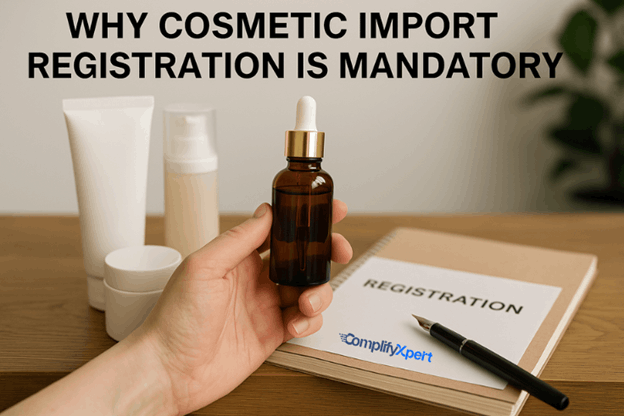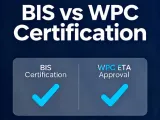The demand for beauty and skin care products is rapidly increasing in India. The Indian cosmetics market was USD 14.6 billion in 2024. It will expand to USD 24.3 billion by 2033 at a compound annual growth rate of 5.9% in the period from 2025 to 2033.
If you are a brand or importer looking to retail cosmetics in India, you must follow certain rules. These rules are part of the Central Drugs Standard Control Organization (CDSCO). You need a cosmetic import license India before any product reaches the stores. This regulatory requirement is required by law and helps in preventing harmful products from reaching the market. This blog will guide you through the entire process in clear, easy-to-follow steps.
Table of Contents
What Is Cosmetic Import Registration?

Cosmetic import registration is a mandatory procedure for importing foreign-manufactured cosmetic products to be sold in India. This process ensures that imported products are safe, suitably labeled, and comply with the Indian law’s health and quality standards. The CDSCO governs this.
To start, the importer must fill out Form COS-1. CDSCO will then review the product and, if approved, give a license called Form COS-2. Without this license, the products will not be allowed through customs and can be stopped at the entry point.
Why Cosmetic Import Registration is Mandatory ?

All foreign cosmetic products entering India must follow the rules set by the Drugs and Cosmetics Act of 1940 and the Cosmetic Rules of 2020. These laws require every product to be registered with the CDSCO before it can be imported. This helps make sure the products are safe for use and meet health standards.
Importing cosmetics into India without official approval is against the law. It can lead to large fines, product seizures, or a permanent ban. That is why having a cosmetic import license in India is helpful and required by law.
Step 1: Understand the Governing Authority
The CDSCO governs all cosmetic import rules in India. This authority reviews all documents, safety data, and labels before granting approval.
The process is handled through the online SUGAM portal. This platform allows importers to submit applications, upload documents, and track status updates. So, if you are looking to bring cosmetics into India, you will be using this system for cosmetics import registration online.
Step 2: Who Can Apply?
Cosmetic registration can only be applied for by a licensed Indian agent, local subsidiary, or authorized importer. You must have:
- A valid Importer Exporter Code (IEC)
- A registered Indian office address
- Authorization from the foreign manufacturer to file on their behalf.
Step 3: Documents Required for Cosmetic Import
When applying for registration, you must submit:
- Power of Attorney from the foreign brand
- Product ingredient list
- Labels in English (and Hindi, if required)
- Free Sale Certificate from the exporting country
- Non-animal testing declaration
- Declaration on heavy metals and banned substances
- Specification and testing protocols
- Packaging and artwork samples
- Safety and efficacy reports (if any)
This complete set makes up the essential documents required for cosmetic import.
Step 4: Fill out the CDSCO Application Forms
For registering cosmetic imports in India, these are the key forms:
- Form COS-1: Application form for registration
- Form COS-2: The official approval certificate issued after successful registration
- Form COS-4: Used for additional product variants under a valid license
You will submit COS-1 first. After approval, CDSCO issues Form COS-2, which serves as your official import registration certificate.
Step 5: Pay the CDSCO Cosmetic Registration Fee
The registration costs depend on the number of products and manufacturing sites. Here is a breakdown of the CDSCO cosmetic registration fee:
- USD 250 per category/brand, payable with Form 42
- USD 50 per product variant
- USD 500 per manufacturing site
All fees are non-refundable and must be paid online via the SUGAM portal before submission.
Step 6: Submit the Application on the SUGAM Portal
Go to the CDSCO SUGAM Portal, create an account, and upload all your details. You will need to:
- Fill in your business and product information
- Upload PDF versions of each required document
- Attach images of product labels and packaging
- Make the required payments
- Once submitted, CDSCO will begin reviewing your application.
Step 7: Review and Issuance of Certificate
After you submit your application, CDSCO experts review your file. They may ask for clarification or more information. It is important to respond quickly to avoid delays.
Once approved, you will receive Form COS-2, the official certificate for import. This certificate must be presented to customs officials each time the products are imported.
Step 8: Validity and Renewal
The cosmetic registration certificate is valid for three years. After that, you are required to apply for renewal. This ensures continued access to the Indian market without gaps or legal problems.
Step 9: Compliance After Registration
Once you have received your license, your work is not done. You still need to follow certain rules.
Here is your cosmetic import compliance checklist:
- Submit annual import reports to the CDSCO
- Make sure every batch has a batch number and expiry date
- Ensure that product labels match approved versions
- Store product safety and import records for review
- Update CDSCO if the formula or packaging changes
Step 10: Customs Clearances
When products reach the port, customs will check for the following:
- Registration certificate (COS-2)
- Labels in the correct format
- Product declaration documents
- Bill of lading, invoice, and packing list
- If anything is missing, the shipment may be delayed or denied.
Step 11: After-Sale Rules
After the product reaches the market, ensure that:
- No advertising claims go against the approved product features
- You report any product recalls or safety issues to the CDSCO
- You don’t sell expired or tampered goods
This is all part of staying compliant with the cosmetic regulation in India.
Common Issues That Lead to Delays or Rejection
If the file is incomplete or contains mistakes, CDSCO may deny approval. Here are some of the typical reasons why applications get rejected:

- Wrong Labels: If your product label does not follow the rules set by BIS (Bureau of Indian Standards), your application can be denied. Labels must have all the right information in the right format.
- No Free Sale Certificate: This certificate shows that the product is sold and accepted in the country where it was made. If it is missing, CDSCO will not approve your file.
- Missing Ingredients or Test Data: You must list all ingredients and share test reports that prove your product is safe. If these are missing or unclear, CDSCO will reject the file.
- Wrong or Unpaid Fees: Every product has a fixed fee. If you forget to pay it or pay the wrong amount, your file will not move forward.
- Incomplete Power of Attorney: A signed authorization letter from the brand allowing the Indian importer to represent them. If this is incorrect or missing key details, your file may get delayed or rejected.
To avoid these problems, double-check everything before you submit. If you are unsure, it is a good idea to get help from someone who has done it before or hire a consultant.
Import License for Cosmetics in India
Another term often used is an import license for cosmetics in India. This is the same as the CDSCO cosmetic registration certificate. Without it, customs will not allow product entry.
So, whether you are a wholesaler, brand owner, or distributor, you need this license to import cosmetics into India legally.
Key CDSCO Forms for Cosmetic Import Registration
| Form Name | Purpose | When to Use |
|---|---|---|
| Form COS-1 | Application for cosmetic import registration | Submit when applying for new imports |
| Form COS-2 | Import license/certificate issues after approval | Received after successful registration |
| Form COS-4 | Application for additional product variants | Used when adding new variants under an existing license |
| Form COS-3 | Application for renewal of cosmetic import license | Submit before the expiry of the current license |
CDSCO Cosmetic Registration: Best Practices

If you want your CDSCO cosmetic registration to go smoothly, follow these simple tips:
- Start Early: The full process takes time, often a few months. Don’t wait until the last minute.
- Check All Documents: Make sure nothing is missing or wrong. A minor error can lead to significant delays.
- Use Good-Quality Scans: Blurry or unclear files can lead to rejection.
- Keep in Touch with CDSCO: After you apply, follow up to check on your file.
Make Files for Each Product: Don’t mix product papers together. Keep a separate folder for each one.
Doing these things helps you avoid problems and saves time.
Wrapping Up
Exporting beauty products to India can be profitable, but only if you follow the law. Only a genuine cosmetic import license India will allow you smooth entry, legal selling, and steady growth. The registration process involves many steps, including procuring documents, paying charges, completing forms, and responding to the CDSCO. It might look hard initially, but this guide helps break it into easy segments.
If you are ready to begin importing cosmetics into India, sign up online today and always have your up-to-date documents with you.






